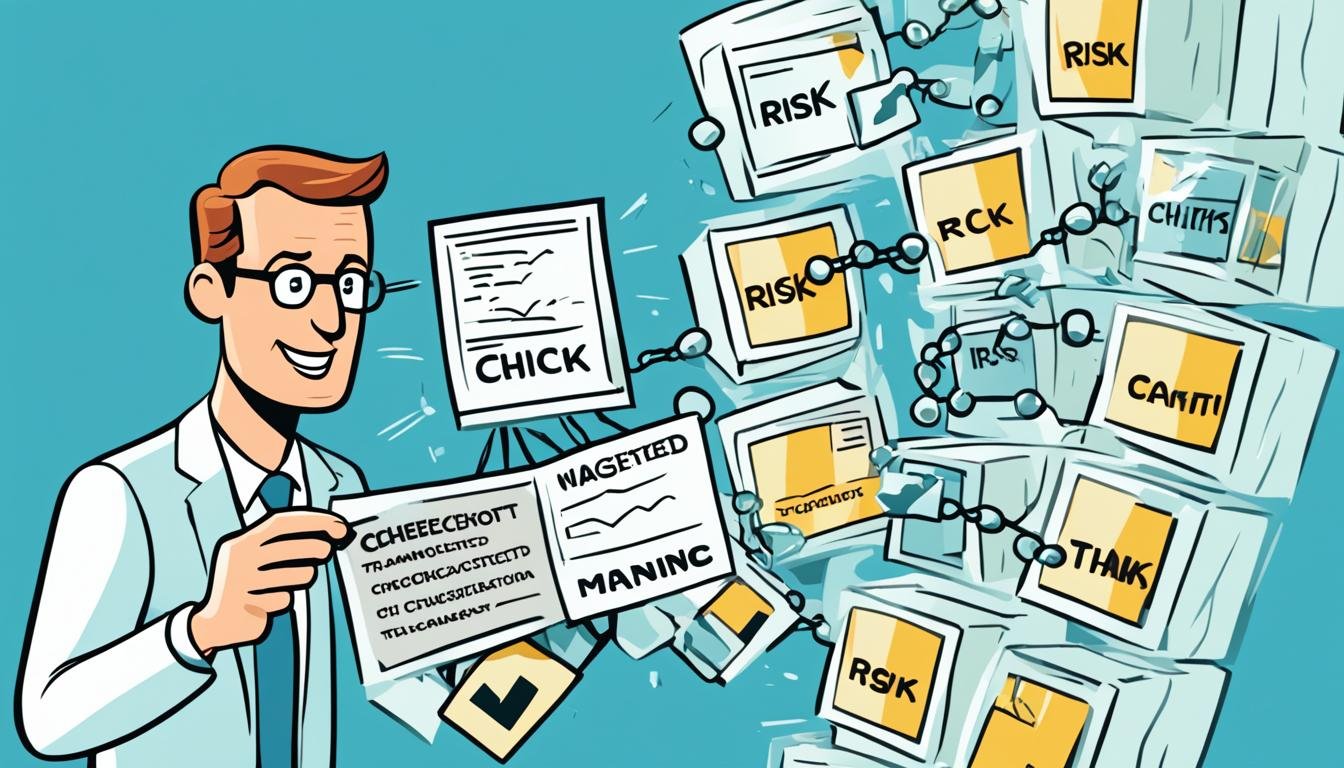Third-Party Risk Management Essentials
Did you know that cybersecurity breaches caused by third-party vendors have increased by 183% in the past year? With the growing reliance on external entities for various aspects of business operations, such as supply chain management and data protection, organizations are faced with significant risks that need to be managed effectively.
Third-party risk management is an essential component of a successful vendor management program. It involves identifying, assessing, and mitigating the risks associated with third-party vendors to protect the organization from potential threats and vulnerabilities.
Key Takeaways:
- Third-party risk management is crucial in mitigating the risks associated with external vendors.
- Cybersecurity breaches caused by third-party vendors have increased by 183% in the past year.
- Organizations need robust systems and processes to manage third-party risk effectively.
- Key features of a third-party risk management system include vendor inventory, risk-based classification automation, vendor and employee engagement, continuous monitoring, system integration, and reporting.
- Effective third-party risk management requires proactive risk mitigation and continuous monitoring.
The Importance of Vendor Inventory and Profiles
A comprehensive third-party risk management system is incomplete without a robust vendor inventory and profiles. These components play a crucial role in effectively managing and mitigating risks associated with third-party vendors. By maintaining an organized and up-to-date inventory, organizations can have a clear view of their vendor landscape, ensuring transparency and accountability in their vendor management program.
The vendor inventory serves as a central repository for all vendor-related information. It should contain essential details such as the vendor’s full legal name, alternate names (if any), primary address, and key contacts. This comprehensive information enables organizations to identify and verify their vendors accurately, minimizing the chances of any confusion or miscommunication.
Furthermore, documentation is a critical aspect of vendor profiles. In addition to basic information, the vendor profile should include relevant documentation, such as SOC (Service Organization Control) reports and insurance certificates. These documents help organizations assess the vendor’s compliance with industry standards and provide insights into their security practices, ultimately contributing to effective risk management.
Effective vendor inventory and profiles are vital for ensuring transparency, accountability, and risk mitigation in vendor management.
An integral part of the vendor profile is the listing of contracts with the vendor. Organizations should maintain a comprehensive record of all contracts, including their status (active or inactive). This allows for easy reference and quick identification of contractual obligations. Additionally, any issues or red flags uncovered during due diligence or ongoing monitoring should be documented in the vendor profile. This information helps organizations assess the vendor’s performance, identify potential risks, and make informed decisions about the continuation of the vendor relationship.
Lastly, the vendor profile should also capture information about the organization’s spend with the vendor. This can be done at either a contract or vendor level, providing insights into the financial impact of vendor relationships. By tracking vendor spend, organizations can assess the value derived from their vendor partnerships and identify opportunities for cost optimization.
Benefits of Comprehensive Vendor Inventory and Profiles:
- Clear visibility of the vendor landscape
- Accurate identification and verification of vendors
- Enhanced compliance and risk management
- Streamlined contract management
- Improved financial analysis and cost optimization
By incorporating a robust vendor inventory and profiles into their third-party risk management system, organizations can establish a solid foundation for effective vendor management. This proactive approach helps mitigate risks, strengthen compliance, and foster transparent and trusted vendor relationships.
Automation of Risk-Based Classification
An effective third-party risk management system employs automation to streamline the risk-based classification process. By implementing a workflow-based process, organizations can efficiently assess new vendors or evaluate existing ones when there are changes in scope. This workflow ensures that every step of the risk assessment is carried out systematically and consistently.
One crucial aspect of the automation process is the inclusion of scoring logic. This logic calculates the vendor’s inherent risk level based on various factors, such as the nature of their operations, the sensitivity of the data they handle, and their compliance history. The resulting risk score plays a key role in determining the level of due diligence required for the vendor.
Moreover, the automated system enables the involvement of internal stakeholders in the risk assessment process. These stakeholders, such as compliance officers and legal representatives, can review and provide approvals for risk assessments. Their expertise and insights significantly contribute to accurate risk evaluation and decision-making.
The Benefits of Automation
Automating the risk-based classification process offers several advantages for organizations:
- Enhanced Efficiency: Automation reduces manual efforts, enabling a faster and more streamlined risk assessment process.
- Consistency and Standardization: With the workflow-based process, organizations can ensure that risk assessments follow consistent criteria and standards.
- Increased Accuracy: The inclusion of scoring logic minimizes subjective judgments and enhances the accuracy of risk assessments.
- Improved Transparency: Automation allows for clear documentation of the risk assessment process, ensuring transparency and accountability.
To illustrate the impact of automation, consider the following example of risk-based classification:
| Risk Level | Description | Due Diligence Level |
|---|---|---|
| High | Significant potential impact on business operations and sensitive data | Comprehensive due diligence: Extensive background checks, site visits, and documentation reviews |
| Medium | Moderate potential impact on business operations and sensitive data | Standard due diligence: Document reviews, financial analysis, and reference checks |
| Low | Minimal potential impact on business operations and sensitive data | Basic due diligence: Questionnaires, vendor self-assessments, and compliance checks |
By automating the risk-based classification process, organizations can prioritize their due diligence efforts based on the vendor’s risk level. This approach allows for efficient allocation of resources, ensuring that higher-risk vendors undergo more rigorous assessments while reducing unnecessary burdens on low-risk vendors.
The automation of risk-based classification empowers organizations to make informed decisions in managing their third-party relationships. With a well-implemented and robust system, organizations can effectively navigate the complexities of third-party risk management and mitigate potential risks proactively.
Vendor and Employee Engagement
The success of a robust third-party risk management program heavily relies on effective vendor and employee engagement. It is essential to establish seamless communication channels and streamline the sharing of information and documentation for a comprehensive understanding of potential risks.
One key feature that enhances vendor engagement is the provision of an easy-to-use portal for vendors to provide necessary information and documentation. This portal should be designed to facilitate a smooth information exchange process while ensuring security and privacy. By creating a user-friendly interface, vendors can easily navigate through the system and provide the required data.
In parallel, organizations need a risk-based due diligence process to assess their vendors effectively. This process involves evaluating the level of risk associated with each vendor, based on factors such as their access to non-public information. With a well-designed system in place, organizations can automate the due diligence process, ensuring that appropriate levels of scrutiny are applied to vendors with higher inherent risks.
Moreover, a vendor engagement system should include an employee-only portal through which staff can request new vendors or propose changes to existing ones. This ensures that the entire organization is involved in the selection and ongoing management of third-party vendors. Workflows can also be triggered to facilitate the assessment and review of vendor requests by the Vendor Management Office, streamlining the overall process.
“Effective vendor engagement and communication are critical aspects of an organization’s third-party risk management program. By implementing user-friendly portals and workflow processes, organizations can streamline collaboration, ensuring smooth information exchange and risk assessment.”
Overall, a well-implemented vendor engagement strategy enables organizations to foster effective communication, promote transparency, and streamline workflows in their third-party risk management processes. By actively engaging vendors and employees, organizations can mitigate risks more efficiently and enhance their overall risk management framework.
Continuous Monitoring
An effective third-party risk management system must facilitate ongoing monitoring of vendor relationships. Continuous monitoring allows organizations to stay vigilant and identify any issues or risks that may arise during the vendor relationship. It involves the implementation of various strategies, including:
- Ongoing Monitoring: Regularly monitoring the activities of third-party vendors to ensure compliance with established policies and standards.
- Vendor Performance Reviews: Conducting periodic reviews to assess the performance and adherence of vendors to agreed-upon metrics and service level agreements.
- Third-Party Intelligence Tools: Leveraging third-party intelligence tools to gain insights into the reputation, financial stability, and cybersecurity practices of vendors.
- Real-time Monitoring: Integrating the third-party risk management system with real-time monitoring tools to receive alerts and notifications about any potential risks or security breaches.
By implementing ongoing monitoring practices, organizations can proactively detect and address any emerging threats or vulnerabilities in their vendor relationships. This helps prevent disruptions to operations, identify and mitigate compliance risks, and safeguard sensitive data.
The Benefits of Continuous Monitoring
Continuous monitoring brings several benefits to organizations, including:
- Early detection of issues or risks, allowing for timely intervention and mitigation.
- Improved vendor performance management through actionable insights and performance metrics.
- Enhanced compliance with regulatory requirements by identifying and addressing non-compliance issues promptly.
- Increased transparency and accountability in vendor relationships.
In summary, continuous monitoring is a vital component of an effective third-party risk management system. By continuously monitoring vendor relationships, organizations can proactively manage risks, ensure compliance, and maintain the security and integrity of their operations.
System Integration
In order to effectively manage third-party risks, organizations need a seamlessly integrated third-party risk management system. This integration allows for efficient data sharing and ensures that relevant information is readily available for risk management purposes.
The integration of the third-party risk management system with other operational tools used by the organization is essential. For example, the system should integrate with the accounts payable (AP) system to pull in spend data. This integration provides a comprehensive view of the organization’s financial relationship with vendors and enables accurate risk assessment based on financial factors.
Furthermore, the third-party risk management system should connect with the organization’s governance, risk, and compliance (GRC) system. This integration enables the seamless transfer of vendor-related issues, such as compliance violations or risk assessments, into the organization’s risk register. By consolidating vendor-related information within the GRC system, organizations can effectively monitor and mitigate risks associated with third-party relationships.
Additionally, system integration enables data integration across multiple platforms and enhances the overall efficiency of the risk management process. By automating the transfer of data between systems, organizations can streamline their risk management activities and reduce the likelihood of errors or data discrepancies.
Benefits of System Integration:
- Efficient data sharing and accessibility
- Comprehensive view of vendor spend and financial relationships
- Seamless transfer of vendor-related issues into the risk register
- Streamlined risk management process
“System integration allows organizations to leverage the full potential of their operational tools and data, enabling better-informed decision-making and proactive risk mitigation.” – John Smith, Risk Management Expert
By integrating the third-party risk management system with other operational tools, organizations can optimize their risk management processes and ensure a holistic approach to third-party risk mitigation.
| Benefits of System Integration | Description |
|---|---|
| Efficient data sharing and accessibility | Enables seamless transfer of data between systems, ensuring easy access to relevant information for risk management purposes. |
| Comprehensive view of vendor spend and financial relationships | Integrates with the accounts payable (AP) system to consolidate spend data, providing insights into the organization’s financial relationships with vendors. |
| Seamless transfer of vendor-related issues into the risk register | Connects with the organization’s governance, risk, and compliance (GRC) system to push vendor-related issues, such as compliance violations or risk assessments, into the risk register. |
| Streamlined risk management process | Automates the transfer of data between systems, improving efficiency and reducing the likelihood of errors or data discrepancies. |
Reporting
Reporting plays a crucial role in a robust third-party risk management system. It enables organizations to track and communicate vendor management activities effectively. Reporting also facilitates data collection for senior management, committees, or the board. By providing comprehensive insights into the organization’s vendor relationships, reporting helps in making informed decisions and ensuring compliance with regulatory requirements.
One of the essential features of reporting is the ability to generate ad hoc reports. This functionality allows users to extract specific information based on their unique needs and requirements. Whether it’s an in-depth analysis of a particular vendor or a summary of overall risk exposure, ad hoc reporting provides flexibility and customization.
Role-based dashboards are another critical aspect of reporting in third-party risk management systems. These dashboards provide users with relevant information based on their roles and responsibilities within the vendor management program. Users can easily access real-time data, view key performance indicators, and monitor the status of ongoing vendor assessments and mitigation activities.
| Benefits of Reporting | Key Features |
|---|---|
| 1. Enhanced transparency and visibility into vendor management activities |
|
| 2. Effective decision-making based on comprehensive data and analysis |
|
| 3. Compliance with regulatory requirements and standards |
|
In conclusion, reporting is a critical component of an effective third-party risk management system. It enables organizations to collect and analyze data, make informed decisions, and ensure compliance with regulatory requirements. Ad hoc reporting and role-based dashboards provide users with customized insights and real-time information, empowering them to proactively manage vendor relationships and mitigate risks effectively.
The Growing Importance of Third-Party Risk Management
Organizations are increasingly recognizing the importance of effective third-party risk management in today’s digital landscape. The rise of data breaches and cybersecurity threats has made it clear that relying on third-party vendors without proper risk management measures can result in severe consequences. From regulatory fines to financial losses and reputational damage, organizations are now more aware than ever of the risks associated with third-party relationships.
However, despite this growing awareness, many organizations still struggle to develop mature third-party risk management programs. They face challenges in implementing robust cybersecurity measures, ensuring compliance with regulations, and effectively managing regulatory risks. As a result, it is crucial for organizations to strengthen their third-party risk management practices and equip themselves with the necessary tactics and success factors to mitigate these risks effectively.
“The cybersecurity landscape is constantly evolving, and organizations need to stay ahead of the curve by proactively managing third-party risks.”
To address the growing importance of third-party risk management, organizations should focus on:
- Developing a comprehensive risk assessment framework that identifies and evaluates potential risks associated with third-party relationships.
- Implementing robust cybersecurity measures and ensuring compliance with data protection regulations to mitigate the risk of data breaches.
- Establishing clear contractual agreements with third-party vendors that outline specific security requirements and compliance obligations.
- Regularly monitoring third-party relationships through continuous risk assessments and auditing mechanisms to detect and address any potential vulnerabilities before they escalate.
“Effective third-party risk management is not a one-time effort; it requires ongoing vigilance and proactive measures to stay one step ahead of emerging threats.”
By prioritizing third-party risk management and incorporating it into their overall risk management strategy, organizations can safeguard their sensitive data, maintain compliance with regulatory frameworks, and protect their valuable reputation.
| Risk Mitigation Strategy | Description |
|---|---|
| Implement strong access controls | Ensure that only authorized personnel have access to sensitive data and systems. |
| Regularly assess vendor cybersecurity practices | Conduct thorough assessments of vendor security protocols to identify potential vulnerabilities. |
| Establish incident response protocols | Develop a well-defined plan to respond to and mitigate the impact of data breaches or security incidents. |
| Stay up to date with compliance regulations | Stay informed about the latest regulatory requirements and ensure compliance with data protection laws. |
| Perform ongoing monitoring and auditing | Regularly monitor vendor activities and conduct audits to ensure ongoing compliance and risk mitigation. |
“A proactive approach to third-party risk management is key to safeguarding your organization against potential cybersecurity threats and regulatory compliance risks.”
The Guiding Principles of Third-Party Risk Management
Third-party risk management programs are built on key principles that outline their approach to assessing and mitigating risks associated with external vendors. These principles form the foundation for effective risk management and ensure that organizations can identify, categorize, and manage third-party risks in a systematic manner.
Risk Categorization
Categories are established to classify risks based on their severity and potential impact on the organization. This allows for targeted risk assessment and the allocation of appropriate resources to manage each category of risk. Categorization helps in prioritizing risk management efforts and ensures that resources are focused on the most critical areas.
Risk Assessment
Risk assessment involves evaluating the potential risks posed by third-party vendors. This process includes analyzing factors such as regulatory compliance, data protection, cybersecurity, and the financial stability of vendors. By conducting thorough risk assessments, organizations can identify vulnerabilities and implement controls to mitigate those risks effectively.
Controls
Implementing controls is crucial for managing third-party risks. Controls are mechanisms put in place to prevent, detect, and respond to risks. They can include measures such as contractual clauses, security audits, vendor performance evaluations, and data protection controls. Effective controls enable organizations to mitigate risks and ensure the security and integrity of their operations.
Monitoring
Continuous monitoring is essential to track the performance and compliance of third-party vendors. This involves periodically reassessing risks, leveraging automation tools for ongoing monitoring, and reviewing vendor performance and adherence to contractual obligations. By monitoring vendors on an ongoing basis, organizations can identify any emerging risks or changes in vendor behavior that may impact their operations.
Accountability
A culture of accountability is vital for successful third-party risk management. Every individual involved in the vendor management process should be accountable for their actions and responsible for complying with the organization’s policies and procedures. Accountability ensures that all stakeholders understand their roles and perform their duties diligently, minimizing the chances of negligence or oversight.
By adhering to these guiding principles, organizations can establish a robust third-party risk management program that effectively addresses the risks associated with external vendors. These principles enable organizations to develop a proactive approach to risk management, identify vulnerabilities, mitigate threats, and maintain the security and integrity of their operations.
Key Principles of Third-Party Risk Management
| Principle | Description |
|---|---|
| Risk Categorization | Establishing categories to classify risks based on severity and impact to prioritize risk management efforts. |
| Risk Assessment | Thoroughly evaluating the risks associated with third-party vendors, including compliance, data protection, and cybersecurity. |
| Controls | Implementing mechanisms such as contractual clauses, security audits, and performance evaluations to mitigate risks. |
| Monitoring | Conducting ongoing monitoring of vendor performance, compliance, and changes in risk exposure. |
| Accountability | Promoting a culture of responsibility and ensuring all stakeholders adhere to policies and procedures. |
Conclusion
In conclusion, third-party risk management is a critical component of any vendor management program. Organizations must prioritize the implementation of effective systems and processes that enable proactive risk mitigation and continuous monitoring of vendor relationships. By adopting best practices in third-party risk management and leveraging robust systems, organizations can significantly reduce the risks associated with data breaches, compliance violations, and operational disruptions caused by third-party vendors.
It is essential for organizations to remain vigilant and adapt their risk management strategies as the landscape of third-party risks continues to evolve. Ongoing monitoring and staying up to date with industry trends and regulatory requirements are crucial in this regard. By continuously assessing and managing risks, organizations can ensure the security and reliability of their third-party relationships, minimizing potential vulnerabilities.
Implementing continuous monitoring practices and employing a proactive approach to risk mitigation are key aspects of effective third-party risk management. By integrating these practices into their vendor management programs, organizations can stay ahead of emerging threats, identify potential risks early on, and take appropriate measures to mitigate them. This proactive approach is essential in safeguarding sensitive data, maintaining compliance with regulations, and protecting the overall integrity of the organization.








